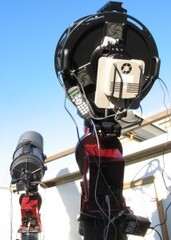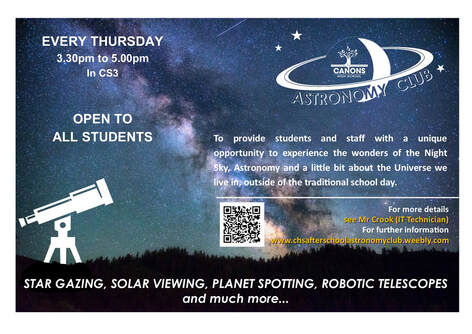CHS After School Astronomy Club
Leader: Mr. S. Crook ( IT Technician ).
AIM:
To provide students and staff with a unique opportunity to experience the wonders of the Night Sky, Astronomy and a little bit about the Universe we live in, outside of the traditional school day.
"sic itur ad astra"
Leader: Mr. S. Crook ( IT Technician ).
AIM:
To provide students and staff with a unique opportunity to experience the wonders of the Night Sky, Astronomy and a little bit about the Universe we live in, outside of the traditional school day.
"sic itur ad astra"
UK Astronomy Calendar
There could be an Earth-like planet 9 in the outer reaches of the Solar System
Click link for Sky at Night Magazine article ->
www.skyatnightmagazine.com/news/earth-like-planet-9-outer-reaches-solar-system?fbclid=IwAR3SIAdmbttVf4D5w2nd7hb0NlTKrpO9GhmcpnHFFYCteHInWf_iKelal2U_aem_AQhCSheHcSPRPbR5vCpNGQRx7w-PSuxhIllq88iYylkY_a-LbTtMmpkP8jDHDwO6Fj0
Click link for Sky at Night Magazine article ->
www.skyatnightmagazine.com/news/earth-like-planet-9-outer-reaches-solar-system?fbclid=IwAR3SIAdmbttVf4D5w2nd7hb0NlTKrpO9GhmcpnHFFYCteHInWf_iKelal2U_aem_AQhCSheHcSPRPbR5vCpNGQRx7w-PSuxhIllq88iYylkY_a-LbTtMmpkP8jDHDwO6Fj0
Chandrayaan-3 - Indian Space Research Organisation (ISRO)
India's first soft landing on the Moon
Click Link -> ISRO:Chandrayaan-3
Click Link -> NSC:Chandrayaan-3
India's first soft landing on the Moon
Click Link -> ISRO:Chandrayaan-3
Click Link -> NSC:Chandrayaan-3
Artemis II - NASA next Moon mission
NASA announces the crew for Artemis’II mission
Click Link for more information -> Artemis II
NASA announces the crew for Artemis’II mission
Click Link for more information -> Artemis II
ESA: Euclid
Euclid is ESA’s space telescope designed to explore the dark Universe. The mission will create the largest, most accurate 3D map of the Universe ever produced across 10 billion years of cosmic time. Euclid will explore how the Universe has expanded and how large-scale structure is distributed across space and time, revealing more about the role of gravity and the nature of dark energy and dark matter.
Click on Link -> Euclid
Click on Link -> Euclid Launch Kit
Click on Link -> Euclid Launch Replay
Click on Link -> Euclid Explore the Mystery of our Expanding Universe
Euclid is ESA’s space telescope designed to explore the dark Universe. The mission will create the largest, most accurate 3D map of the Universe ever produced across 10 billion years of cosmic time. Euclid will explore how the Universe has expanded and how large-scale structure is distributed across space and time, revealing more about the role of gravity and the nature of dark energy and dark matter.
Click on Link -> Euclid
Click on Link -> Euclid Launch Kit
Click on Link -> Euclid Launch Replay
Click on Link -> Euclid Explore the Mystery of our Expanding Universe
Exploring the Moons of the Planet Jupiter
ESA : Juice
Jupiter Icy Moons Explorer
Scheduled Launch Window April 2023
ESA’s Jupiter Icy Moons Explorer, Juice, will make detailed observations of the giant gas planet and its three large ocean-bearing moons – Ganymede, Callisto and Europa – with a suite of remote sensing, geophysical and in situ instruments. The mission will characterise these moons as both planetary objects and possible habitats, explore Jupiter’s complex environment in depth, and study the wider Jupiter system as an archetype for gas giants across the Universe.
Click on Link -> JUICE
NASA : Europa Clipper
EUROPA : Moon of Jupiter - Potential for Life
Scheduled Launch October 2024
In 2024, The Journey begins: Clipper is being crafted with one overarching goal :
To determine if Europa harbors conditions suitable for life.
Click on Link -> EuropaClipper
ESA : Juice
Jupiter Icy Moons Explorer
Scheduled Launch Window April 2023
ESA’s Jupiter Icy Moons Explorer, Juice, will make detailed observations of the giant gas planet and its three large ocean-bearing moons – Ganymede, Callisto and Europa – with a suite of remote sensing, geophysical and in situ instruments. The mission will characterise these moons as both planetary objects and possible habitats, explore Jupiter’s complex environment in depth, and study the wider Jupiter system as an archetype for gas giants across the Universe.
Click on Link -> JUICE
NASA : Europa Clipper
EUROPA : Moon of Jupiter - Potential for Life
Scheduled Launch October 2024
In 2024, The Journey begins: Clipper is being crafted with one overarching goal :
To determine if Europa harbors conditions suitable for life.
Click on Link -> EuropaClipper
The Vera C Rubin Telescope
Project Mission StatementRubin Observatory’s mission is to build a well-understood system that will produce an unprecedented astronomical data set for studies of the deep and dynamic universe, make the data widely accessible to a diverse community of scientists, and engage the public to explore the Universe with us.
Overview
The goal of the Vera C. Rubin Observatory project is to conduct the 10-year Legacy Survey of Space and Time (LSST). LSST will deliver a 500 petabyte set of images and data products that will address some of the most pressing questions about the structure and evolution of the universe and the objects in it.
Click Link -> RubinObservatory
Project Mission StatementRubin Observatory’s mission is to build a well-understood system that will produce an unprecedented astronomical data set for studies of the deep and dynamic universe, make the data widely accessible to a diverse community of scientists, and engage the public to explore the Universe with us.
Overview
The goal of the Vera C. Rubin Observatory project is to conduct the 10-year Legacy Survey of Space and Time (LSST). LSST will deliver a 500 petabyte set of images and data products that will address some of the most pressing questions about the structure and evolution of the universe and the objects in it.
Click Link -> RubinObservatory
WOMANTHOLOGY
Connecting women and opportunity
Womanthology is a digital magazine and professional community powered by female energy and ingenuity.
Click on Link -> Issue 142: Women in Space, April 2022
Connecting women and opportunity
Womanthology is a digital magazine and professional community powered by female energy and ingenuity.
Click on Link -> Issue 142: Women in Space, April 2022
James Webb Telescope
JWST makes first detection of crucial carbon molecule in a planet-forming disc
Click Link for Further Information -> JWST: Carbon Molecule Discovery
Click link for JWT Images - JWTImages
Click link where is the JWT - WhereisJWST
Click link for JWT Blog - JWTBlog
JWST measures temperature of an exoplanet - JWST-Exoplanet
Astronomers work out when the first stars shone
They say that this period, known as the "cosmic dawn," occurred between 250 to 350 million years after the Big Bang.
The results indicate that the first galaxies will be bright enough to be seen by Nasa's James Webb Space Telescope, which is set to be launched later this year.
Click on link -> FirstStars
They say that this period, known as the "cosmic dawn," occurred between 250 to 350 million years after the Big Bang.
The results indicate that the first galaxies will be bright enough to be seen by Nasa's James Webb Space Telescope, which is set to be launched later this year.
Click on link -> FirstStars
 The 17″ and 14″ units part of the Virtual Telescope
The 17″ and 14″ units part of the Virtual Telescope
The Virtual Telescope Project 2.0
Remotely controlled Robotic Telescopes, online!
Enjoy the real Universe from your desktop, live!
Welcome to the Virtual Telescope Project, a very powerful set of real, robotic telescopes, remotely accessible online, through the Internet for your very own astronomical experience! Here you will learn about its many features, making it a unique and leading facility in the world.
Click on Link -> VirtualTelescope
Remotely controlled Robotic Telescopes, online!
Enjoy the real Universe from your desktop, live!
Welcome to the Virtual Telescope Project, a very powerful set of real, robotic telescopes, remotely accessible online, through the Internet for your very own astronomical experience! Here you will learn about its many features, making it a unique and leading facility in the world.
Click on Link -> VirtualTelescope
NASA Voyager Space Probes
The Voyager program is an ongoing American scientific program that employs two robotic interstellar probes, Voyager 1 and Voyager 2. They were launched in 1977 to take advantage of a favourable alignment of Jupiter and Saturn, to fly near them while collecting data for transmission back to Earth.
They have now left our Solar System.
Click on Link -> NASA:Voyager
Solar Exploration
Click on Link -> NASA - ParkerSolarProbe
Click on Link -> ESA-SolarOrbiter
Click on Link -> SoundsoftheSolarWind
Click on Link -> NASA - ParkerSolarProbe
Click on Link -> ESA-SolarOrbiter
Click on Link -> SoundsoftheSolarWind
Mars Exploration.
Click on Link -> NASA - Perseverance Mars Rover
Click on Link -> NASA - Where is Perseverance
Click on Link -> NASA - Ingenuity Mars Helicopter
Click on Link -> Emirates - HOPE Probe
Click on Link -> NASA - Perseverance Mars Rover
Click on Link -> NASA - Where is Perseverance
Click on Link -> NASA - Ingenuity Mars Helicopter
Click on Link -> Emirates - HOPE Probe
Exoplanet Exploration: Planets beyond our Solar System
Click on Link -> NASA - Exoplanet Exploration
Click for Link -> NASA - TESS
Click on Link -> WASP - Exoplanets
Click on Link -> ESA - CHEOPS
Click on Link -> ESA - MultiExoPlanetSystemImage
Click on Link -> Keck - PlanetFinder
Click on Link -> NASA - Exoplanet Exploration
Click for Link -> NASA - TESS
Click on Link -> WASP - Exoplanets
Click on Link -> ESA - CHEOPS
Click on Link -> ESA - MultiExoPlanetSystemImage
Click on Link -> Keck - PlanetFinder

